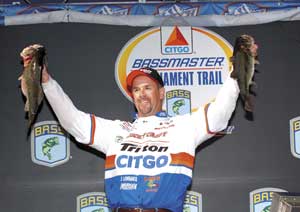
North Carolina bass pro Marty Stone got a look at what he thought was the worm rig of the future when he was a pro staffer at Florida-based Gambler Lures.He loved the idea behind Gambler’s “Florida-rig” screw-lock weight, but it wasn’t until after the company changed hands, the management team was shaken up, and he wound up on the Tru-Tungsten fishing team that he said the self-pegging worm weight reached its potential.
Of course, he’s slightly biased, since the first product he helped the Tru-Tungsten folks develop was a screw-in weight, the “T-Rig.”
“It’s no big secret,” said Stone, who has qualified for four Bassmasters Classics. “Gambler had its Florida-rig weight before its ownership changed, and we were close to making a tungsten version, but we weren’t quite there yet. Then, when the company changed ownership and management, I came over to Tru-Tungsten, and I had a hand in designing a weight like the Florida rig that was made of tungsten.
“We got together with an idea of what the weight should do. We took the basic idea and improved on it several ways.”
First, Stone said, there’s no comparison between a traditional lead worm weight and one made of tungsten, a much more dense element that allows fishermen to use much weights that are much smaller in size but deliver the performance of heavier ones.
“Tungsten is more dense than lead, the smaller weights are easier to fish, and tungsten is 10 times more sensitive than lead,” he said. “It’s perfect for flipping a (plastic) crawfish in that matted hydrilla at Shearon Harris.”
The weight, being smaller in size, will get through tight spots easier than a standard worm weight. The dense nature of the tungsten — which is now a popular substitute for lead shot among waterfowlers — will also all the weights to punch through heavy cover, especially grass, to get your bait down to the waiting fish. They come in sizes as small as 1/32 ounce to 1 1/2 ounces.
Second, Tru-Tungsten substituted a corkscrew wire made of titanium for the standard Gambler wire, Stone said. That improvement was huge in two different areas. First, Stone said, titanium is so resilient no matter how much abuse it takes in hooksets and battles with bass, the corkscrew will snap back to the same position and shape every time. That allowed Tru-Tungsten to eliminate the plastic sleeve that protruded from the underside of the Gambler weight and fit inside the wire.
“One of the bigger handicaps you had with the Florida-rig was the sleeve,” Stone said. “If you didn’t rig your plastic just right, the eye of the hook could jerk up and hit the end of that sleeve, and you would lose some of your hook-setting power. With the titanium wire, the sleeve is gone, and the wire will collapse on the hookset and stay out of your way. Then, it will spring back into place, always in its original shape.”
Stone said Tru-Tungsten developed a sophisticated painting process that eliminates the paint from chipping off the weight, and the company also developed a process by which the T-Rig weights — and all of the company’s tungsten products — could be painted to match basic colors of soft plastics: black/blue, brown, june bug, watermelon seed, blood red, green pumpkin, black, transparent chartreuse and plain.
“I think we’ve got an excellent weight now,” Stone said. “The Florida rig was lead; it had the sleeve; it had regular wire for the screw-lock; and the paint could chip; it wasn’t durable. We’ve tried to address what we felt we could improve.”
Tru-Tungsten recently acquired the entire line of Picasso baits, and Stone said he’ll be involved in a redesign of the spinnerbait line. That will give the pro from the suburbs of Fayetteville a hand in three big projects in a year’s time — the biggest perhaps being an 18-foot Bass Cat boat that will carry his signature: the Marty Stone Sabre FTD.
According to details released by the company, the boat will have an enlarged front deck, plus an area where rods can be stored away from the trolling motor.
It should debut this month, perhaps in time for the Bassmasters Classic at Alabama’s Lay Lake.




Be the first to comment